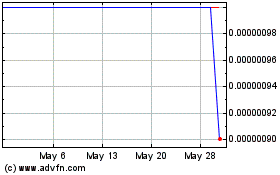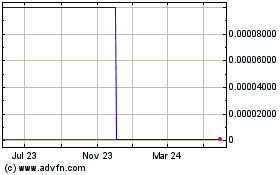Global Technologies Group, Inc. Results of Cement Plant Mercury Emissions Testing
26 April 2012 - 12:38AM
Marketwired
Global Technologies Group, Inc. (PINKSHEETS: GTGP) presents report
dated April 20, 2012 for Mercury emissions testing completed by MSE
Technology Applications, Inc.
Cement Plant Mercury Emissions Testing Using
MBS
The United States Environmental Protection Agency (EPA) will
implement new mercury emissions regulations in 2013 and many cement
plants will not be able to meet the more stringent regulations.
Some of these cement plants have installed powdered activated
carbon (PAC) systems in an attempt to reduce
mercury emissions to comply with the new regulations. However,
mercury emissions have not been reduced enough to meet the new
regulations at some of the plants.
Global Technologies Group, Inc. (Global) contracted MSE
Technology Applications, Inc. (MSE) to perform a series of tests to
determine if Molecular Bonding System (MBS), a metals treatment
agent, can reduce mercury concentrations within a moist gas stream
at elevated temperatures. MBS has historically been used to bond
with metals in contaminated soils and has also been previously
tested to reduce mercury emissions in a power plant with
success.
Four tests were conducted using MBS, PAC and a mixture of MBS
and PAC as the treatment agents to reduce mercury concentrations in
a flow-through testing apparatus which simulated actual plant
conditions. A picture of the test apparatus is shown in Figure
1.
The reaction column was packed with denstone, glass wool, and 10
grams of the treatment agent(s) and placed on top of the reaction
flask after the system was brought to temperature. The reaction
flask contained approximately milliliters 5(mL) of elemental
mercury. Nitrogen flow was initiated at 0.5 Liters per minute
(L/min) and allowed to flow through the water flask into the
mercury flask and up the reaction column through the treatment
agent(s). The water flask was heated to 130°F to produce ~ 17%
moisture in the system and the mercury flask and reaction column
were heated to 250°F to mimic typical cement bag house
temperatures.
Test 1 used 100% PAC with a 17% moisture content. Test 2 used
100% MBS with 17% moisture content. Test 3 used 90% PAC and 10% MBS
with 17% moisture content. Test 4 used 100% MBS without any
moisture in the system.
The tests were all run for the same period of time, using the
same gas flow rate, and the same temperatures to produce similar
mercury concentrations within the mercury flask and reaction
column. After the tests were completed, the reaction column was
removed from the mercury flask and the treatment agent(s) were
removed, mixed, split into samples and submitted to the MSE
Analytical Laboratory for mercury analysis using EPA, SW-846 Method
7471. Table 1 shows the test details and mercury concentration
levels for the samples submitted.
Since the cement plant currently uses PAC to reduce mercury
emissions,
Test # 1 was designed to be the baseline test and used only PAC
in the reaction column. The PAC removed an average
of 96 mg/Kg of mercury from the vapor phase in the test
system.
Test # 2 used only MBS in the reaction column
and the average mercury reduction was 501 mg/Kg, indicating that
MBS can remove more than five times the amount of mercury than
the PAC.
Test # 3 used a combination of 90% PAC and 10% MBS and that
combination of materials removed an average of 230 mg/Kg from the vapor phase of
the test system. Test # 3 results indicate that
the 10% addition of MBS to the PAC can remove more than twice as
much mercury than the PAC.
Test # 4 was conducted to determine if MBS could reduce mercury
concentrations in a dry environment, which could represent an upset
condition at the cement plant. The results for
Test # 4 show that MBS in a dry environment removed an average of
398 mg/Kg of mercury from the test system. The average amount
of mercury that was removed from each test was plotted and that
graph is presented in Figure 2.
The testing indicates that MBS removes elemental mercury vapor
from a hot nitrogen gas phase. Testing is being conducted to
determine if any acid gases, NOX or SOX will be generated using MBS
with compressed air in the test system this week.
"The validated Mercury emissions report is part
of the data that will be presented to the Portland Cement
Association, EPA and other agencies of the government here in the
United States and abroad. The results were impressive to both MSE
and the cement plant, as the use of MBS/IFSC2 without the use of
PAC can remove more than five times the
amount of mercury than the PAC. I believe that now we will be the
benchmark for Mercury removal and rid our people of a very
dangerous airbornetoxin not only here but worldwide," stated James Fallacaro,
President.
Global Technologies Group, Inc. (GLOBAL) is a company that is in
the business of acquiring exclusive licenses and distribution and
reseller contracts on proven technologies in the environmental,
green and war fighter industries. The criteria for the licensing or
distribution agreements of the technologies are: they must be
proven, validated and in use. The business plan of Global is to
sublicense the technologies it acquires to companies in Countries
covered under the original license grants and for its own use. For
our exclusive distribution and reseller agreements, we partner with
appropriate representatives in the covered countries for resale of
turn key projects. Solucorp Industries is the patent holder and
licensor of the MBS/IFS2C technology.
Image Available:
http://www2.marketwire.com/mw/frame_mw?attachid=1961130 Image
Available: http://www2.marketwire.com/mw/frame_mw?attachid=1961136
Image Available:
http://www2.marketwire.com/mw/frame_mw?attachid=1961139
Contact: JAMES FALLACARO Email Contact 941-685-1616
WWW.GLBTECH.COM
Global Technologies (CE) (USOTC:GTGP)
Historical Stock Chart
From Oct 2024 to Nov 2024

Global Technologies (CE) (USOTC:GTGP)
Historical Stock Chart
From Nov 2023 to Nov 2024
